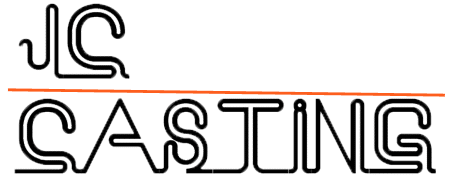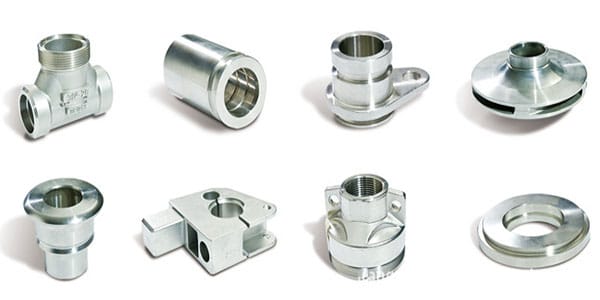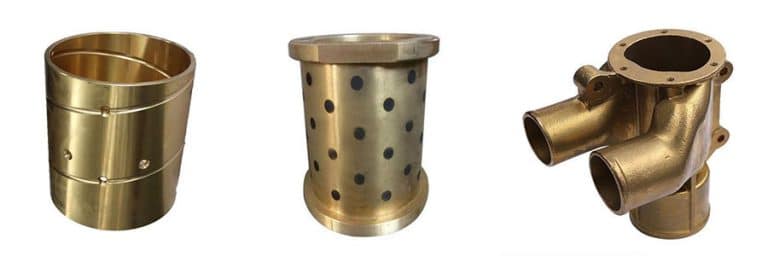Die Casting Defects and Remedies
Flow marks
Other names: stripes.
Characteristics: The surface of the casting exhibits a smooth texture with partial depression. It is consistent with the flow direction of the molten metal. The defect has no fixed orientation and can be removed by polishing.
The reason:
- 1. The traces of the two strands of metal are out of sync with the cavity.
- 2, the mold temperature is low, such as zinc alloy mold temperature is lower than 150 ° C, aluminum alloy mold temperature is lower than 180 ° C, are prone to such defects.
- 3. Filling speed is too fast.
- 4. Too much coating.
Solutions
- 1. Adjust the cross-sectional area or position of the ingate.
- 2. Adjust the mold temperature and increase the overflow tank.
- 3. Adjust the filling speed appropriately to change the flow state of the molten metal filled chamber.
- 4. Use thin and even paint
Cold water barrier
Other names: cold knot (butt), water pattern.
Feature:
The gap in which the low temperature metal stream is but not fused has an irregular linear shape. Both penetrating and non-penetrating. And there is a tendency to develop under the influence of external forces.
The reason:
- 1. The molten metal has a low pouring temperature or a low mold temperature.
- 2. The alloy composition does not meet the standard and the fluidity is poor.
- 3. The metal liquid is poorly melted.
- 4. The unreasonable process is too long.
- 5. Low filling speed or poor exhaust.
- 6. The pressure is low.
Solutions
- 1. Properly increase the casting temperature and mold temperature.
- 2. Change the composition of the alloy to improve fluidity.
- 3. Improve the gating system, increase the gate speed and improve the filling conditions.
- 4. Improve spillovers and increase spillovers.
- 5. Increase the injection speed and improve the exhaust conditions.
- 6. Increase the specific pressure.
Contusion
Other names: tension, pull marks, sticky scars.
Feature:
In the demolding direction, the inclination of the mold is too small to cause scratches on the surface of the casting due to the adhesion of the metal, and when it is severe, it becomes a hard surface.
The reason:
- 1. The casting inclination of the core and profile walls is too small or the inclination is reversed.
- 2. The core and the walls are indented.
- 3. Alloy bonding mold.
- 4. Casting deflection or mandrel tilting.
- 5. The surface is very rough.
- 6. The paint is often not sprayed.
- 7. The iron content in the aluminum alloy is less than 0.6%.
Solutions
- 1. Correct the mold to ensure the slope is manufactured.
- 2, lighting indentation.
- 3. Reasonably design the gating system to avoid metal flow to the core and wall, and reduce the filling speed appropriately.
- 4. Correct the mold structure.
- 5. Polish the surface.
- 6. The coating amount is thin and uniform, and spray paint cannot be sprayed.
- 7. Appropriately increase the iron content to 0.6~0.8%.
Bubble
Other names: bubbling.
Features: Under the skin of the casting, the bubble is formed by the expansion of the gas.
The reason:
- 1. The mold temperature is too high.
- 2. The filling speed is too high. The metal flow involves too much gas.
- 3.The paint contains a lot of gas and it is too much. It does not burn before pouring. Therefore volatile gases are encased on the surface of the casting.
- 4, the exhaust is not smooth.
- 5, the mold is too early.
- 6. The melting temperature of the alloy is too high.
Solutions
- 1. Cool the mold to the operating temperature.
- 2. Reduce the injection speed and avoid eddy currents.
- 3. Select a coating containing a small amount of gas, the coating is thin and uniform, and the mold is closed after combustion.
- 4. Clean and add overflow tank and exhaust pipe.
- 5. Adjust the mold retention time.
- 6. Trimming the smelting process.
Stomata
Other names: air holes, air eyes.
Features: The shape of the gas formed inside the die casting is relatively regular. The surface is smooth.
Cause: mainly caused by wrapping gas.
- 1. The gate position selection and the shape of the diversion are improper. The molten metal enters the cavity to generate a frontal impact and generate a vortex.
- 2. The shape of the runner is poorly designed.
- 3. The pressure chamber is not full enough.
- 4. The speed of the ingate is too high, causing turbulence.
- 5, the exhaust is not smooth.
- 6. The mold cavity is too deep.
- 7, too much paint, not burned before filling.
- 8, the charge is not clean, poor refining.
- 9. The machining allowance is too large.
Remedy:
- 1. Select the gate position and the shape of the diversion that are conducive to the gas removal in the cavity, so as to prevent the metal liquid from first closing the drainage system on the parting surface.
- 2. The nozzle cross-sectional area of the sprue should be as large as possible than the cross-sectional area of the ingate.
- 3. Increase the fullness of the pressure chamber, use a smaller pressure chamber as much as possible and use quantitative casting.
- 4. Increase the thickness of the ingate to reduce the filling speed under conditions that are well formed.
- 5. Open the overflow tank and the exhaust passage at the last filling position of the cavity, and avoid that the overflow tank and the exhaust passage are closed by the molten metal.
- 6. Open the exhaust plug at the deep cavity and increase the exhaust by inserting.
- 7. The coating amount is thin and uniform, and it is filled after burning, and a coating with small gas generation is used.
- 8. The charge must be cleaned and dried, and the smelting process must be strictly observed.
- 9. Adjust the conversion point of the shot speed, slow shot speed and fast shot speed.
- 10. Reduce the pouring temperature and increase the specific pressure.
Shrinkage cavity
Other names: shrinking eyes, shrinking.
Features:
During the condensation process of the die-casting part, the internal compensation is insufficient to cause irregularly shaped holes with rough surfaces.
Cause:
- 1. The alloy pouring temperature is too high.
- 2. The wall thickness of the casting structure is not uniform, resulting in a hot section.
- 3. The pressure is too low.
- 4. The overflow tank has insufficient capacity and the overflow is too thin.
- 5. The filling chamber is too small. The remaining material is too thin, and the final filling does not work.
- 6. The inner gate is small.
- 7. The local temperature of the mold is too high.
Remedy:
- 1. Obey the alloy melting specification and reduce the pouring temperature.
- 2. Improve the structure of the casting. Eliminate the accumulation of metal. Uniform wall thickness and slow transition.
- 3. Appropriately increase the specific pressure.
- 4. Increase the capacity of the overflow tank and thicken the overflow.
- 5. Improve the filling degree of the pressure chamber. Quantitative casting is adopted.
- 6. Appropriately improve the pouring system so that the pressure is well transmitted.
Pattern
Feature:
The smooth stripe on the surface of the casting is visible to the naked eye. However, it cannot be felt by hand. The color is different from the texture of the base metal. It can be removed with a few rubs of 0# abrasive cloth.
Cause:
- 1. The filling speed is too fast.
- 2. The amount of paint used is too much.
- 3. The mold temperature is low.
Remedy:
- 1. Reduce the injection speed as much as possible.
- 2. The coating amount is thin and uniform.
- 3. Increase the mold temperature.
Crack
Feature:
The alloy matrix on the casting is broken or broken to form a filament-like gap. There are two types of penetration and non-penetration.
Cracks can be divided into cold cracks and hot cracks. The main difference is that the metal at the crack of the cold crack casting is not oxidized, and the metal at the crack of the hot crack casting is oxidized.
Cause:
- 1. The structure of the casting is unreasonable. The shrinkage is hindered and the fillet of the casting is too small.
- 2, and the top core pulling apparatus skew occurs in operation, discontinuity.
- 3. The mold temperature is low.
- 4. The mold opening and core pulling time is too late.
- 5. If the alloy is improper or the harmful impurities are too high, the plasticity of the alloy will decrease. Zinc alloy: lead, tin, cadmium, iron high aluminum alloy: zinc, copper, iron is high Copper alloy: zinc, silicon high magnesium alloy: aluminum, silicon, iron is high.
Remedy:
- 1. Improve the structure of the casting, reduce the difference in wall thickness, and increase the casting fillet.
- 2. Correct the mold structure.
- 3. Improve the working temperature of the mold.
- 4. Shorten the mold opening and core pulling time.
- 5. Strictly control harmful impurities and adjust alloy composition
Less casting
Other names: insufficient pouring, unclear outline, and missing corners.
Characteristics: The molten metal is not filled with the cavity. The incomplete parts of the casting appear.
Cause:
1. The alloy flow is poor: (1) The metal liquid has a high gas content and severe oxidation, so that the fluidity decreases. (2) The alloy casting temperature and the mold temperature are too low. (3) The speed of the gate is too low. (4) The nitrogen pressure in the accumulator is insufficient. (5) The pressure chamber is full. (6) The design of the casting wall is too thin or the thickness is not appropriate.
2, poor casting system caused: (1) improper location of gate location, diversion method, number of gates. (2) The cross-sectional area of the gate is too small. 3. Poor exhaust conditions: (1) Exhaust gas is not smooth. (2) Excessive paint, not burned out. (3) The mold temperature is too high. The gas pressure in the cavity is high and it is not easy to discharge.
Remedy:
1. Improve the fluidity of the alloy: (1) Use the correct smelting process to remove gases and non-metallic inclusions. (2) Appropriately increase the alloy casting temperature and mold temperature. (3) Increase the injection speed. (4) Replenish nitrogen to increase the effective pressure. (5) Quantitative casting. (6) Improve the structure of the casting and adjust the wall thickness appropriately.
2, improve the pouring system: (1) the correct choice of gate location and diversion method. It is advantageous to use multiple ingates for non-conform shape castings and large castings. (2) Increase the cross-sectional area of the ingate or increase the injection speed.
3. Improve the exhaust conditions: (1) Add an overflow tank and an exhaust passage. A vent plug can be opened at the deep concave cavity. (2) The paint is thin and uniform. After the blow is dry, the mold is closed. (3) Lower the mold temperature to the working temperature.
Impression
Other names: putt impressions, inserts, or moving blocks splicing impressions.
Characteristics: The surface of the casting is exposed by the mold cavity and the protruding and concave marks left by the splicing of the parts such as the push rod, the insert and the movable block.
Cause:
- 1. The push rod is not adjusted properly or the end is worn.
- 2. The mold cavity, the slider splicing part and its active part are not well matched.
- 3. The putter area is too small.
Remedy:
- 1. Adjust the push rod to the correct position.
- 2. Fasten the inserts or other moving parts to eliminate the uneven parts that should not be present.
- 3. Increase the area of the putter or increase the number.
Mesh burr
Other names: mesh traces, mesh patterns, crack burrs.
Features: Reticulated embossed marks and metal thorns on the surface of the casting due to thermal fatigue on the surface of the mold cavity.
Cause:
- 1. Traces caused by cracks on the surface of the mold cavity, the heat conduction near the gate area is the most concentrated, the frictional resistance is the largest, the erosion of the molten metal is the strongest, the hot and cold alternating is the most dramatic, the most prone to hot cracking, forming the turtle crack.
- 2. The mold material is improper or the heat treatment process is not correct.
- 3. The temperature difference between the mold and the hot and cold is large.
- 4. The casting temperature of the alloy liquid is too high, and the mold preheating is not enough.
- 5. The surface roughness Ra of the mold cavity is too large.
- 6. The metal flow rate is too high and the front side is flushed.
Remedy:
- 1. Correct selection of mold materials and reasonable heat treatment process.
- 2. The mold must be preheated to the working temperature range before die casting.
- 3. Reduce the alloy casting temperature as much as possible.
- 4. Improve the surface quality of the mold cavity and reduce the Ra value.
- 5. The insert is periodically annealed to eliminate stress.
- 6. Design the gating system correctly, and use a small injection speed as much as possible under the conditions of good forming.
Colored spots
Other names: oil spots, black spots.
Features:
Spots on the surface of the casting that differ from the base metal are typically formed from the coating carbide.
Cause:
- 1. The paint is not pure or used too much.
- 2. The coating contains too much graphite.
Remedy:
- 1. The paint should be thin and uniform, and should not be piled up. It should be blown away with compressed air.
- 2. Reduce the graphite content in the coating or use a graphite-free water-based coating.
Noodles
Feature:
During the filling process, due to the mold temperature or the temperature of the alloy liquid is too low, a fine pitted distribution area formed on the surface of the casting under the condition of under-pressure is obtained.
Cause:
- 1. The metal is dispersed into dense droplets during filling, and the wall is impacted at high speed.
- 2. The thickness of the ingate is too small.
Remedy:
- 1. Design the casting system correctly. Avoid splashing of molten metal, improve exhaust conditions, avoid excessive flow of liquid into the flow, reduce the speed of the gate and increase the mold temperature.
- 2. Adjust the thickness of the ingate properly.
Flash
Other names: quilting.
Features: Metal foil that appears on the edge of the casting.
Cause:
- 1. The clamping force of the machine before the injection is not well adjusted.
- 2. The mold and the slider are damaged, and the blocking component is invalid.
- 3. The mold inserts and the slider are worn.
- 4, the mold strength is not enough to cause deformation.
- 5. The debris on the parting surface is not cleaned up.
- 6. The projected area is not calculated correctly and exceeds the clamping force.
- 7. The injection speed is too high, and the pressure shock peak is too high.
Remedy:
- 1. Check the clamping force or the pressure increase condition, and adjust the injection pressure boosting mechanism to reduce the peak pressure of the injection pressure.
- 2. Check the damage degree of the mold slider and trim it to ensure that the blocking component plays a role.
- 3. Check the wear and repair.
- 4. Calculate the mold strength correctly.
- 5. Remove debris from the parting surface.
- 6. Correctly calculate and adjust the clamping force.
- 7. Adjust the injection speed appropriately.


